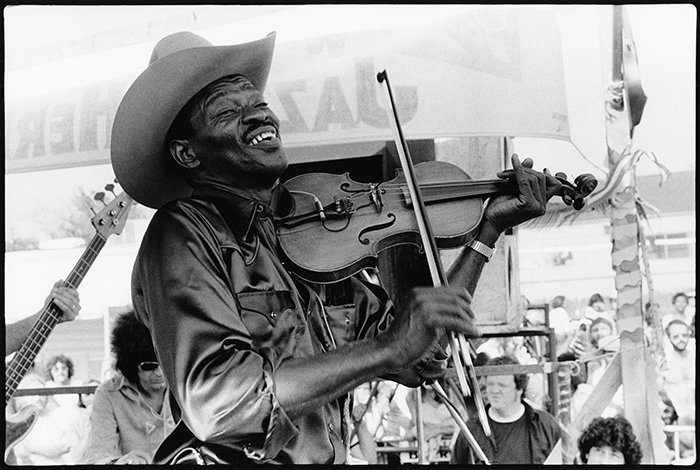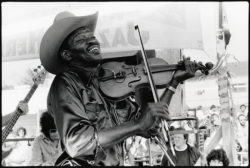Gatemouth Brown
Though described as a blues guitarist, Clarence "Gatemouth" Brown embraced a variety of music genres and musical instruments, including the violin, viola, mandolin, mandola, harmonica, and drums.

THE HISTORIC NEW ORLEANS COLLECTION
Clarence "Gatemouth" Brown at New Orleans Jazz Festival, 1976.
Though usually described as a blues guitarist, Clarence “Gatemouth” Brown embraced a wide variety of music genres and played a variety of musical instruments, including the violin, viola, mandolin, mandola, harmonica, and drums. Brown’s versatility led the New York Times to describe him as someone who “spent his career fighting purism by synthesizing old blues, country, jazz, Cajun and R&B styles.” Though he established himself with his 1954 Peacock Records single “Okie Dokie Stomp,” Brown spent years playing rhythm and blues (R&B) on the southern “chitlin” circuit. His 1982 Grammy for the album Alright Again! was just one highlight in a long and varied musical career.
Background and Early Career
Clarence Brown was born in Vinton on April 18, 1924, the son of Tom and Virginia Brown. He was raised just across the border in Orange, Texas, allowing both states to claim him as a native son. At a young age, he learned to play fiddle and guitar from his father, a railroad worker who enjoyed entertaining family and friends with traditional Cajun, bluegrass, and country songs (as well as any other music that caught his ear). Brown cited his father as his greatest influence, once stating, “If I can make my guitar sound like my father’s fiddle, then I know I’ve got it right.” Brown continued to play music with his family and joined a San Antonio R&B band as a drummer in 1945, before a brief stint in the Army.
After his military service, Brown made his debut at Don Robey’s Bronze Peacock Club in Houston. Brown was present in the audience when an ill T-Bone Walker had to make an early exit. Jumping on the stage, Brown used Walker’s guitar to wow the audience and Robey with an impromptu performance of an instrumental he called “Gatemouth Boogie.” After the performance, Robey took Brown under his wing and helped him get a contract with Aladdin Records in Los Angeles. Brown recorded only two singles with Aladdin in 1947 and 1948. Though they received little in the way of promotion, Louisiana Weekly took notice, calling Brown “the wonder man” who “does things with a guitar and can really chirp the blues” in its October 11, 1947, issue.
Career Successes
Disappointed that Brown’s career was not taking off as quickly as anticipated, Robey founded Peacock Records specifically to release Brown’s music. (Peacock Records was the first record label owned and operated by an African American.) Brown’s single “Mary Is Fine” scored a regional hit for the label in 1949 and Peacock continued releasing Brown’s recordings until 1959. Brown’s signature tune, “Okie Dokie Stomp,” features relentless solos over a punchy horn section. Brown recalled naming this instrumental, recorded in 1954, for a New Orleans radio disc jockey who sat in on the recording sessions: “We called him ‘Okie Dokie,’ so we called it his stomp. I’m glad we did because this tune went all over the globe.”
“Okie Dokie Stomp” exemplified Brown’s style, which inspired guitarists from Guitar Slim to Frank Zappa. Among the figures who influenced his sound are T-Bone Walker, Louis Jordan, and big band jazz acts such as Count Basie and Duke Ellington. Brown also cited his father as an important influence. The Peacock singles reflect the influence of musical genres ranging from Texas blues to rock ‘n’ roll; his final Peacock release, “Just Before Dawn,” even includes some Cajun/country fiddling.
During this period, Brown worked many New Orleans nightclubs, including the Dew Drop Inn. He made a name for himself with his high-energy set, undeniable talent, and flashy clothes. At the beginning of the 1960s, Brown set out to release records that stretched the musical boundaries of his Peacock releases. In the mid-1960s, he moved to Nashville to continue as bandleader on the syndicated television show The Beat, a full-color music showcase that lasted from 1965 to 1967. There, he backed southern R&B stars like Etta James, Joe Tex, Lou Rawls, and Freddie King.
Brown’s expressive fiddle playing and proficiency in country music increasingly drew listeners’ attention. In 1965 he recorded Little Jimmy Dickens’s “May the Bird of Paradise Fly Up Your Nose” for Hermitage Records. He also befriended Roy Clark, with whom he would record years later. Brown also made several appearances on the long-running country music show Hee Haw.
Later Years
During the late 1960s, Brown took a break from the entertainment world. After a brief move to Colorado, where he played honky-tonks and served as a Durango County deputy sheriff, Brown settled in Aztec, New Mexico. Meanwhile, his fan base in Europe and Japan grew, as listeners unearthed American roots music of all types, including Brown’s recordings for Peacock during the 1940s and 1950s. In 1971, a French promoter located Brown and invited him to perform at the Montreux Jazz Festival in Switzerland. His acceptance led to many return trips to Europe and new recordings for the French labels Black & Blue and Barclay. The Drifter Rides Again, released on Barclay in 1972, won critical acclaim and a major award in France, marking Brown’s reemergence an important recording artist.
Brown earned the title of official ambassador for American music by participating in several tours sponsored by the US State Department. Throughout the 1970s, he toured Europe twelve times and enjoyed extensive visits to Russia, Japan, and eastern Africa. Always ready to point out that he was not a bluesman, he dressed for these performances in a cowboy hat, cowboy boots, and western-style shirts; he also smoked a pipe. Blues, jazz, Cajun, country, and even calypso were equally represented in his live sets.
In 1974 Brown recorded with New Orleans pianist Professor Longhair, most notably on the Rock & Roll Gumbo album. In 1978 the independent label Music Is Medicine released his first American full-length album, Blackjack. By this time, Brown had permanently returned to Louisiana and was living in New Orleans. Rounder Records signed Brown in 1981 and the resulting album, Alright Again!, won a Grammy for best traditional blues recording. Brown also won the first of several W. C. Handy Awards in 1982. The Rhythm & Blues Foundation presented him with its Pioneer Award in 1997, and in 1999, he was inducted into the Blues Foundation’s Hall of Fame. His final album, Timeless, was released in 2004 on the independent label Hightone. In September 2004, Brown was diagnosed with lung cancer. Having lived with emphysema and heart disease for some time, he refused treatment and decided to die doing what he loved. One of his last live appearances was a defiant one at the 2005 New Orleans Jazz & Heritage Festival. Later that year, Hurricane Katrina destroyed his home in Slidell. Before the storm, he evacuated to Orange, Texas, where he died of heart failure on September 10, at the age of 81. Brown left behind a prolific body of work, including numerous singles and twenty original albums.
